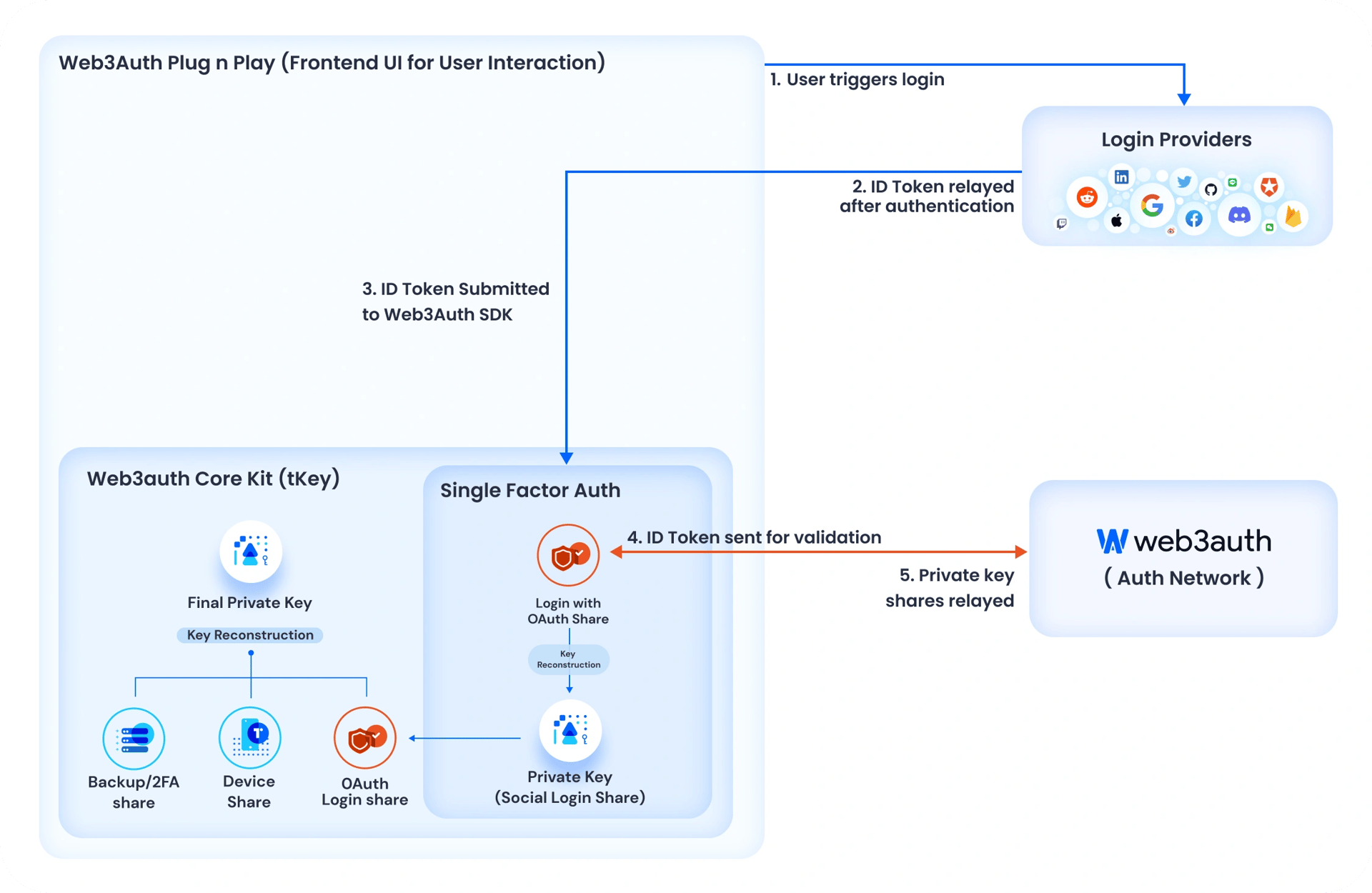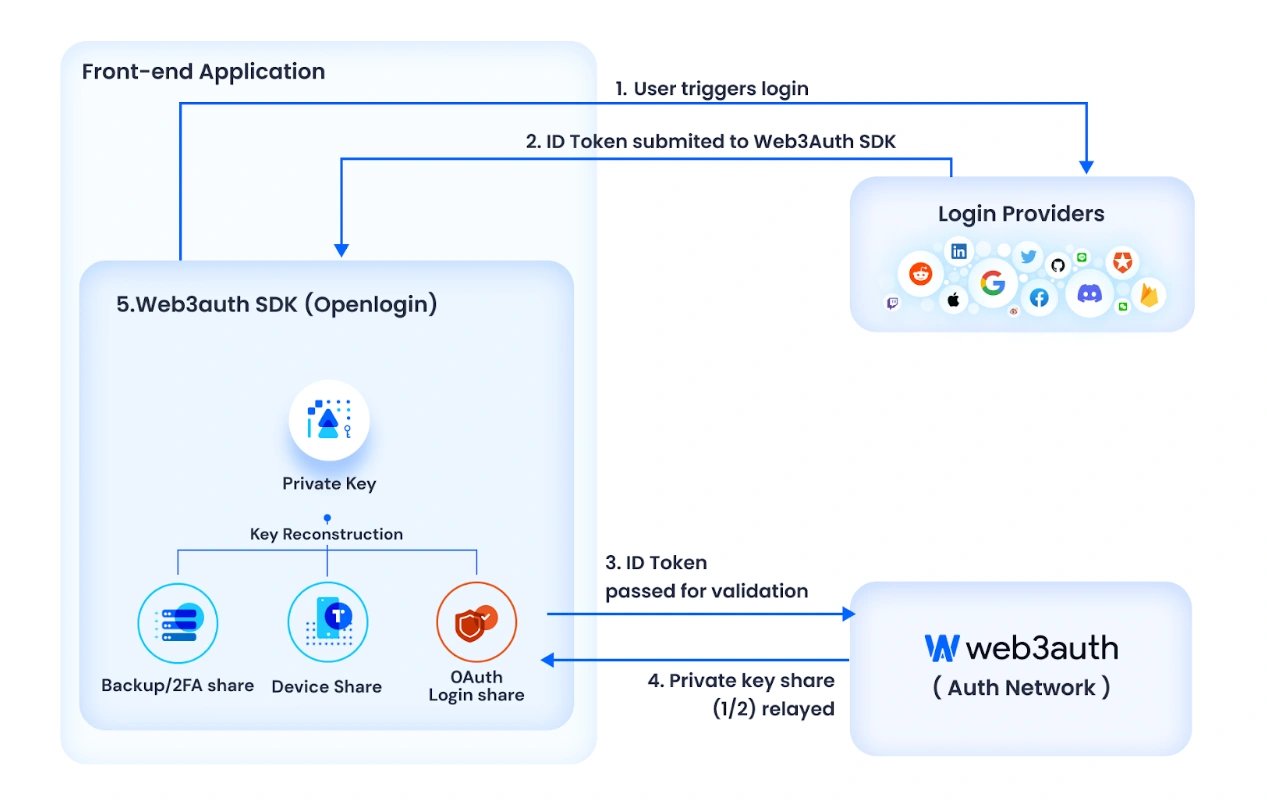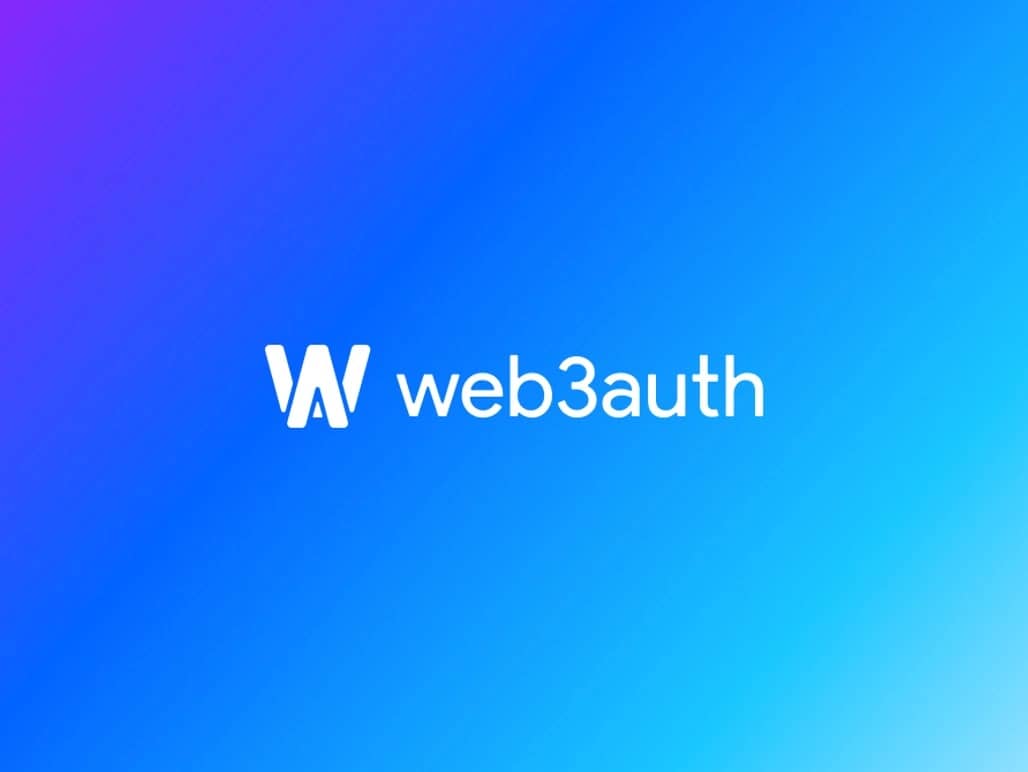Web3Auth
Web3Auth는 Web3 지갑 및 애플리케이션을 위한 플러그형 지갑 인프라입니다. 일반 사용자와 암호화폐 사용자 모두에게 친숙한 경험을 제공하여 1분 이내에 온보딩을 간소화합니다. [1][2]
개요
탈중앙화 애플리케이션 (dApp) 또는 블록체인 지갑에 Web3Auth를 통합하면 사용자 온보딩 프로세스를 간소화할 수 있습니다. Web3Auth를 통해 사용자는 지갑 관리 시스템의 비보관 특성을 유지할 수 있습니다. 즉, 사용자는 자신의 암호화 지갑에 대한 완전한 제어권과 소유권을 유지하여 블록체인 기술의 개인 정보 보호 및 보안 원칙을 강화합니다. [1][3]
기존 지갑과 달리 Web3Auth는 사용자 상호 작용을 간소화하고 트랜잭션 제어를 향상시키기 위해 사용자 정의 흐름 조정을 제공합니다. 각 사용자와 애플리케이션에 고유한 표준 암호화 키를 생성하여 트랜잭션 서명 및 기타 지갑 작업을 용이하게 합니다. [2]
Web3Auth는 지갑 기능을 향상시키지만, 독립형 지갑이 아니라 인프라로서 기능한다는 점을 이해하는 것이 중요합니다. [3]
2023년 4월, Web3Auth는 Trust Wallet과 파트너십을 맺어 사용자 경험을 개선하고 Web3의 대중적 채택을 가속화했습니다. [10]
“분실된 시드 구문은 매우 혼란스러운 문제이며, 매년 암호화폐에서 수십억 달러가 손실되는 것을 언급해야 합니다. 시드 구문은 영구적으로 사라져야 할 때입니다. 이것은 2단계 지갑의 장기적인 채택의 시작일 뿐이며, Trust Wallet과의 이번 파트너십은 모든 사람을 위한 엔터프라이즈급 MPC 민주화를 위한 우리의 노력에 있어서 엄청난 진전입니다.” - Zhen Yu Yong, Web3Auth 공동 설립자 겸 CEO [10]
현재까지 Web3Auth는 10,000개 이상의 dApp에 지원을 제공했으며, 50,000명 이상의 개발자와 월 2,000만 명 이상의 사용자를 보유하고 있습니다. 또한 Animoca Brands, Binance와 같은 Web3 브랜드와 Fox.com, SK Planet, Universal Studios, Mcdonald’s를 포함한 포춘 500대 기업과 협력했습니다.
Web3Auth 기술
상위 아키텍처
Web3Auth SDK는 사용자/애플리케이션의 프런트엔드 클라이언트에만 존재하며 OAuth 제공업체와 Auth 네트워크 간의 상호 작용을 처리합니다. 아래 다이어그램은 Web3Auth SDK와 통합 애플리케이션 간의 관계를 설명합니다. [4]

사용자가 Google과 같은 로그인 제공업체로 로그인하면 앱에 JWT id_token을 보냅니다. 이 JWT 토큰은 Web3Auth SDK의 로그인 기능으로 전송되어 검증되고 자체 보관 방식으로 개인 키가 생성됩니다.

플러그 앤 플레이 SDK
Web3Auth 플러그 앤 플레이 통합 프로세스는 개발자 친화적으로 설계되어 Web3Auth SDK를 초기화하고 필요한 구성을 설정하기만 하면 됩니다. 애플리케이션에 통합되면 SDK는 로그인 기능의 임베딩을 용이하게 합니다. 이를 통해 개발자는 SDK를 사용하여 로그인 버튼이나 사용자 트리거 이벤트를 통해 활성화할 수 있는 connect 함수를 호출하여 사용자를 인증할 수 있습니다. [4]
코어 키트 SDK
코어 키트 SDK는 Web3Auth 플러그 앤 플레이(PnP) SDK의 기반입니다. 이는 Web3Auth 인프라의 본질을 형성하며 탈중앙화 애플리케이션(dApp) 내에서 직접 사용하여 더욱 심층적인 통합을 가능하게 합니다. 이는 두 가지 유형의 SDK로 더 나뉩니다.
- 단일 요소 인증 SDK
- 다중 요소 SDK(예: tKey SDK)
MPC SDK
Web3Auth 인프라를 사용하면 사용자의 키가 여러 부분으로 나뉘어 사용자의 기기와 Auth 네트워크에 분산됩니다. 이를 통해 사용자의 키는 항상 액세스 가능하며 단일 위치에 저장되지 않습니다. [4]
기존 Web3Auth SDK에서는 Shamir의 비밀 공유를 사용하여 프런트엔드에서 키가 동적으로 재구성되었습니다. 그러나 임계값 서명 체계(TSS)를 사용하는 새로운 Web3Auth MPC(다중 당사자 컴퓨팅) 아키텍처를 사용하면 키가 재구성되지 않습니다. 대신 부분 키가 여러 위치에 저장되고 사용자의 다양한 인증 요소가 메시지/트랜잭션에 대한 부분 서명을 생성합니다. 그런 다음 이러한 부분 서명은 임계값 서명 체계(TSS)를 사용하여 프런트엔드에서 계산 및 결합되어 최종 서명을 생성하며, 이는 블록체인 트랜잭션에 사용할 수 있습니다.
TSS는 분산 키 생성 및 서명을 위한 암호화 원시 함수입니다. Web3Auth의 Auth 네트워크에 TSS를 통합하는 것은 수많은 보안상의 이점을 제공하는 새로운 패러다임을 나타냅니다. [4]
